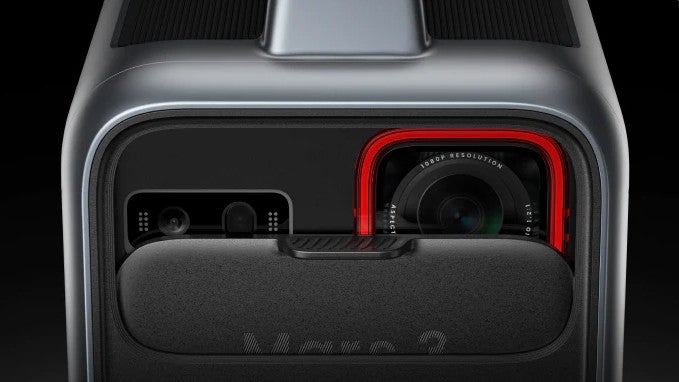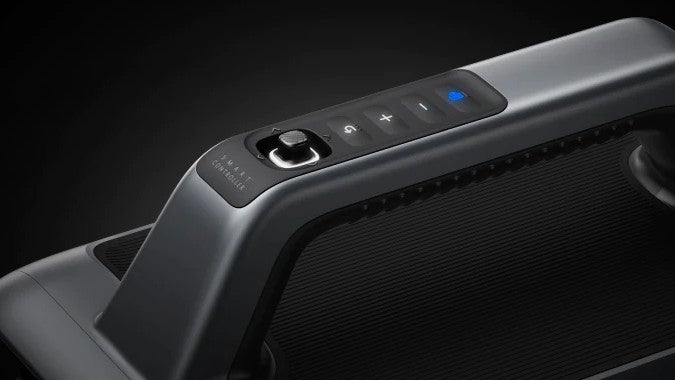To help us provide you with free impartial advice, we may earn a commission if you buy through links on our site. Learn more

- Rugged, portable design
- Excellent battery life
- Strong 1080p image quality
- No native Netflix app
- Minor UI issues
With claims that the Nebula Mars 3 is the ultimate outdoor projector, having spent a couple of weeks with it, they might have a point.
All too often, manufacturers of portable projectors focus on making them more compact, or improving picture quality, but then forget the practicalities, like how quick and easy is it to set up, especially outdoors? Or how long does the battery last? Of course, image and sound quality are important, and there are times when being able to cram a projector into a backpack takes priority, yet you’re left to wonder what’s the point when it sputters out of charge after eighty minutes, leaving you scrambling for an extension cable to get your outdoor movie night back on track.
The Nebula Mars 3 is all about the practicalities. It’s on the large side for a portable projector, but it’s one of the few we’ve seen that will make it through a summer blockbuster without conking out, and possibly even two. It also has a decent specification and plenty of evidence that some thought went into the design.
Nebula Mars 3 review: What do you get for the money?
The Mars 3 is a DLP-based portable projector with a 1080p resolution and a 1,000 ANSI Lumens maximum brightness level – specs which put it squarely in the top tier of portable projectors. It also features built-in Android TV 11 streaming, with access to the Google Play store, and a 40W Dolby Audio sound system, giving you everything you need in one box, as long as you’re in reach of Wi-Fi. Crucially, it has a 185Wh battery, enabling you to run the projector for up to five hours without needing to plug into the mains.
Beyond this, the projector has a range of features designed to make projection easier in more casual or outdoor settings. The rectangular design with carrying handle may make it look more like an old-fashioned high-power torch than a projector, but the thick, rubbery casing and chunky lens cover keeps it IPX3 water resistant, not to mention dust and drop-resistant. Meanwhile, smart auto-adjustment features are included to ensure that you get a straight, sharply focused image in just about any situation, with the minimum amount of tweaking, right down to matching the brightness output against the ambient light levels in the area.

The connections are covered by another thick, water-resistant flap, and include the DC input for the bundles power supply, HDMI and auxiliary audio inputs, and both USB Type-C and Type-A connections – which can also be used to power a streaming stick or charge a smartphone or tablet, provided the projector is switched on. It also has built-in Chromecast features in case you’d rather stream content directly from your phone. And the built-in lamp below the connections is another nice touch, giving you three levels of soft lighting should you need it as your outdoor movie night comes to a close.
Meanwhile, basic controls are integrated into the carrying handle, so you don’t actually need to take the slimline remote control outdoors with you if you’re worried about losing it. READ NEXT: The best outdoor projectors to buy
Nebula Mars 3 review: What does it do well?
Firstly, setup is really easy. It takes you through connecting the projector to your home Wi-Fi network and setting it up with your Google account, and you can either do this manually or use the ‘set up my device wizard’ on an Android phone. After that, it’s just a matter of installing apps from the Google Play store and adding your credentials – anything stored with your account should just pass through. Then you’re ready to point the projector at a screen.
The automatic focus and keystone adjustments work a treat, so while the focus and alignment can be adjusted manually, I didn’t have much call to. The projector is also fairly flexible about angles and off-centre positioning, though the image quality suffers slightly the further you stray from dead-on. There’s no optical zoom, and no vertical adjustment, other than a flip-out stand which angles the projector upwards. However, the short 1.20:1 throw ratio means you don’t need a huge amount of distance to get a good-sized image – for a 100-inch diagonal, you’re only looking at a distance of 2.7m.
The Android TV 11 implementation remains close to stock and most of the most popular apps are supported, with one major exception that we’ll come to in a minute. It’s also relatively easy to change image modes and settings, though the Mars 3 doesn’t offer a huge range of adjustments. There are just three preset modes – Standard, Movies, and Bright – along with a Custom mode with more in-depth contrast and colour settings, if you want a little extra fine control.

As for the Mars 3’s image quality, it’s impressive by the standards of most portable projectors, making the most of the potential 1,000 ANSI Lumens of brightness and the 1080p resolution. The DLP chip makes for dark blacks and vibrant colours, which can look over-egged or artificial in places, but more often looks natural or cinematic. There’s occasional murkiness in some tones, or some weird fringing around the edges, but nothing that really spoils the picture. The Mars 3 packs enough brightness to deliver a viewable image with reasonable contrast while indoors during daylight hours, or outdoors before the sun has disappeared, though I’d still suggest waiting until twilight if you want your films and TV shows to really pop.
With most portable projectors, you have to make some compromises over brightness, clarity, or colour reproduction, but the Mars 3 handles a wide range of material well, including the gloomy tones and neon oranges of The Batman and the rich, punchy hues of Disney’s Encanto. You don’t get quite the same level of detail and definition as the XGIMI Halo+, or the colour performance of the XGIMI Mogo 2 Pro, but with 84.5% sRGB and 70.9% DCI-P3 coverage, it’s still capable of reproducing a wider range of tones than most LED-based portables.
I’m almost as pleased with the Mars 3’s meaty audio. With three speakers and 40W to play with, it’s powerful enough for a decent movie night, and clear enough to carry dialogue and do justice to the score and effects. At higher volumes things do start to get a little rough and boisterous, and you can’t expect convincing stereo or surround effects from such a compact source, but it’s good enough that you can do without separate speakers or a soundbar.

Though perhaps the biggest plus point for the Mars 3 is its battery life. In tests, streaming episodes from Netflix, we actually made it through just over five hours on Eco Mode, with brightness levels of 300 ANSI Lumens that I found were still fine for night-time viewing. Of course, if you switch to the Standard Mode brightness setting, or run the speakers loud, you will find that time reduced, but this isn’t one of those projectors where you’ll be sitting on the edge of your seat, wondering if it’s going to make it to the end of the movie. In fact, you should have enough juice for a double bill, so long as you’re not screening long-drawn-out epics.
Nebula Mars 3 review: What could it do better?
The one major weakness that the Mars 3 has is the Netflix support. The regular Netflix Android app simply isn’t available through the Google Play store, and so the Mars 3 ships with, what I suspect is, a browser-based app that was originally designed to be driven with a mouse, rather than a remote control. What this means is that you’re using the D-pad on the remote to navigate the UI and select content, which makes it a pretty painful process. What’s more, the actual image quality looks inferior to running Netflix through a Roku 4K streaming stick, with more compression artefacts creeping in.
We also experienced some odd moments in other areas when the UI seemed to struggle: failing to close the Amazon Prime app, or temporarily hanging when we tried to back out of YouTube.
Luckily, you always have the option of running a streaming stick via the HDMI connection if you want a better Netflix experience, and these other issues didn’t crop up most of the time. READ NEXT: The best cheap projectors to buy
Nebula Mars 3 review: Should you buy one?
If your priorities are portability and having a projector you can rely on indoors or out, then yes, you should buy one. The Mars 3 makes setup and configuration easy, while the rugged build and weather-resistant features will give you confidence that your projector won’t go kaput if there’s a sudden shower. What’s more, both the image and audio quality are well above the average for a 1080p portable projector, even rivalling some more conventional home cinema models.
It’s worth remembering that there are some excellent non-portable projectors out there for around £1,000, including a clutch of 4K models with superior image quality and HDR support. But, while you should check out our best projectors guide for the top living room models, the Nebula Mars 3 is the best outdoor projector we’ve tested.







